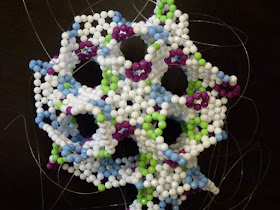From the pink model, one can find that these octagons can be classified into three classes. The relative positions of these three types of octagons can be easily identified. So in order to minimize the chance of making mistakes, one should use three different colors for octagons. The photos shown below is the bead model of GGS I made last weekend. Using three different kinds of colors, the relative positions of these octagons are vividly displayed. The hard part I have now is to find a way to terminate this structure.
1. At the beginning: every octagon is surrounded by four other octagons belonging to the other two classes. You may be able to see other local rules for these octagons in this photo. Global rule is more complicated to be described here without a schematic plot.

2. Monkey saddle: Here is an interesting direction to view the GGS. One can see a coronene located right at the position of a monkey saddle. Surrounding a coronene, there are six octagons.

3. View it from x-direction

4. View it from y-direction

The normal of every octagon with the same color is lying along the same coordination axis of the three dimensional Cartesian coordinate system.
No comments:
Post a Comment